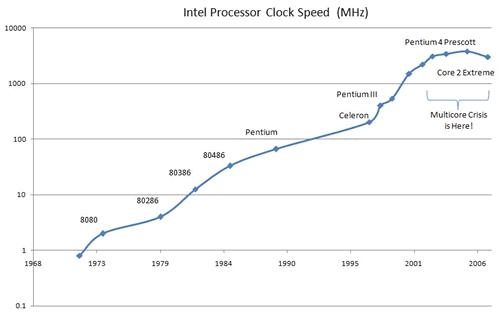guitarist473
The UMMU that can play guitar
- Joined
- Feb 1, 2009
- Messages
- 196
- Reaction score
- 0
- Points
- 0
- Location
- Long Eaton, Nottinghamshire England
Here's a though...
Paying the PC shop to build my new pc for me and being in control on its specs got me wondering earlier...
What will the assortment of RAM and Processors be like in the future?
For gaming? or daily life? or work? or... anything? like suggested in this article i read...
http://sciindustry.com/Computers.html
This portrays what computers will assist with in our daily lifes into the future...
But knowing us lot, we would probably be playing orbiter 2020P1 in super hi-def Level 30 textures and Ravenstar Mk-VII with super Interactive touch screen moniters and over 500fps.
So what do you think computers will be like... and capable of in the future?
My opinion...
10 years - Super Processors so games (like orbiter) can handle the crazy stuff above.
20 years - computers help us control our money, house, health, work, everything else.
50 years - complete interactiveness, be able to surf the internet shops, not by clicking, but by immersing yourself in a fully interactive 3D environment, ebay will be like a real-life super market, all simulatored by a headset, goggles and sensors of some sort. and any material goods will be able to instantly materialise for use at the touch of the finger... (no mouse in a 3d interactive enviroment) whether it be food, clothing or accesories.
100+ years - Something similar to the Holodeck or like that movie (gamer) i think its called?
http://www.imdb.com/media/rm1878165504/tt1034032
500+ years - so our population doesnt have to suffer through what our fragile planet will probably become to by them, all people will abandon their material form for a life of data and variables, living completly inside a super-massivly multiplayer super server computer. we will have a choice, become a online data stream, or go into space and look for a new planet.
(i dont support this, im all for space exploration, and finding new habitable planets, this is a
'just if' because of the topic this is on)
What you guys think?

EDIT
This looks quite interesting too...
http://www.microsoft.com/surface/en/us/default.aspx
...Maybe my 50 year mark should be alot earlier :O
Paying the PC shop to build my new pc for me and being in control on its specs got me wondering earlier...
What will the assortment of RAM and Processors be like in the future?
For gaming? or daily life? or work? or... anything? like suggested in this article i read...
http://sciindustry.com/Computers.html
This portrays what computers will assist with in our daily lifes into the future...
But knowing us lot, we would probably be playing orbiter 2020P1 in super hi-def Level 30 textures and Ravenstar Mk-VII with super Interactive touch screen moniters and over 500fps.
So what do you think computers will be like... and capable of in the future?
My opinion...
10 years - Super Processors so games (like orbiter) can handle the crazy stuff above.
20 years - computers help us control our money, house, health, work, everything else.
50 years - complete interactiveness, be able to surf the internet shops, not by clicking, but by immersing yourself in a fully interactive 3D environment, ebay will be like a real-life super market, all simulatored by a headset, goggles and sensors of some sort. and any material goods will be able to instantly materialise for use at the touch of the finger... (no mouse in a 3d interactive enviroment) whether it be food, clothing or accesories.
100+ years - Something similar to the Holodeck or like that movie (gamer) i think its called?
http://www.imdb.com/media/rm1878165504/tt1034032
500+ years - so our population doesnt have to suffer through what our fragile planet will probably become to by them, all people will abandon their material form for a life of data and variables, living completly inside a super-massivly multiplayer super server computer. we will have a choice, become a online data stream, or go into space and look for a new planet.
(i dont support this, im all for space exploration, and finding new habitable planets, this is a
'just if' because of the topic this is on)
What you guys think?

EDIT
This looks quite interesting too...
http://www.microsoft.com/surface/en/us/default.aspx
...Maybe my 50 year mark should be alot earlier :O
Last edited:


